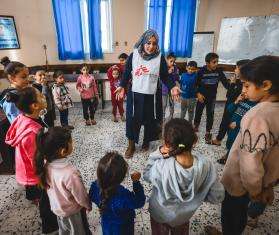Dire Consequences for Children Under Two
New York/Geneva, April 23, 2008 – As food aid is mobilized in response to the global food price crisis, the international medical humanitarian organization Doctors Without Borders/Médecins Sans Frontières (MSF) warns that sending adult food to feed young children will not save them from the risk of malnutrition. Today MSF urged donors to ensure their aid includes special foods for young children.
MSF supports calls for increased food aid to families, but this will not be enough.
“We see that when food prices rise the first thing to be reduced or cut out are things like milk products that young kids need most,” said Dr. Susan Shepherd, nutritional advisor for MSF’s Access Campaign. “This is why it is so urgent that donors not only provide enriched flours, which are designed to meet the needs of adults, but also help supply foods specifically designed for growing kids.”
In some places where MSF works, food prices are rising alarmingly. For example, the price of sugar, flour, oil, and rice increased by 40 percent in Sierra Leone from December to February, according to MSF’s monitoring of local markets. This is concerning because during the 2005 Niger food crisis, when the price of millet tripled, MSF clinics were inundated with malnourished children.
Conventional food aid continues to provide children with inadequate foods, such as fortified blended flours that do not contain all the nutrients that a young child needs. Children require diets that contain specific nutrients included in animal-source food, like those in milk. Without essential nutrients, young children are at risk for malnutrition that leads to increased vulnerability to disease and increased risk of death.
“Unfortunately, donors continue to apply a ‘one size fits all’ approach to nutritional aid,” said Dr. Shepherd. “The wrong food aid can mean children will still get malnourished and fall ill, or die unnecessarily.”
Nutritionally, a critical window of time for children is from six months to two years of age. At six months, a mother typically starts to supplement breastfeeding her child with other foods. But for mothers in the world’s ‘malnutrition hotspots,’ such as Africa’s Horn and Sahel regions and parts of Asia, it is difficult to meet a child’s nutritional needs, either because it is too costly, or because adequate foods are simply not available. The situation becomes more acute when food prices rise.
Changing food aid to meet children’s needs is possible. Nutrient-rich and dense foods geared to the specific needs of young children exist, and have been used successfully by ministries of health and international organizations. Ready-to-use foods (RUFs) which require no cooking, added water, or refrigeration, deliver the full range of nutrients a child needs in an energy-dense paste made with essential ingredients, including milk powder. MSF is calling on donor governments to change current food aid programs and develop strategies on providing food supplements.
Ideally, families should be able to buy diversified food to feed their children, but when this is not possible, supplements should be made accessible to ensure that children do not become malnourished.
Malnutrition is a medical emergency that contributes to five million deaths in children under five each year. The World Health Organization estimates there are 178 million children that are malnourished across the globe, and at any given moment, 20 million are suffering from the most severe form of malnutrition.



